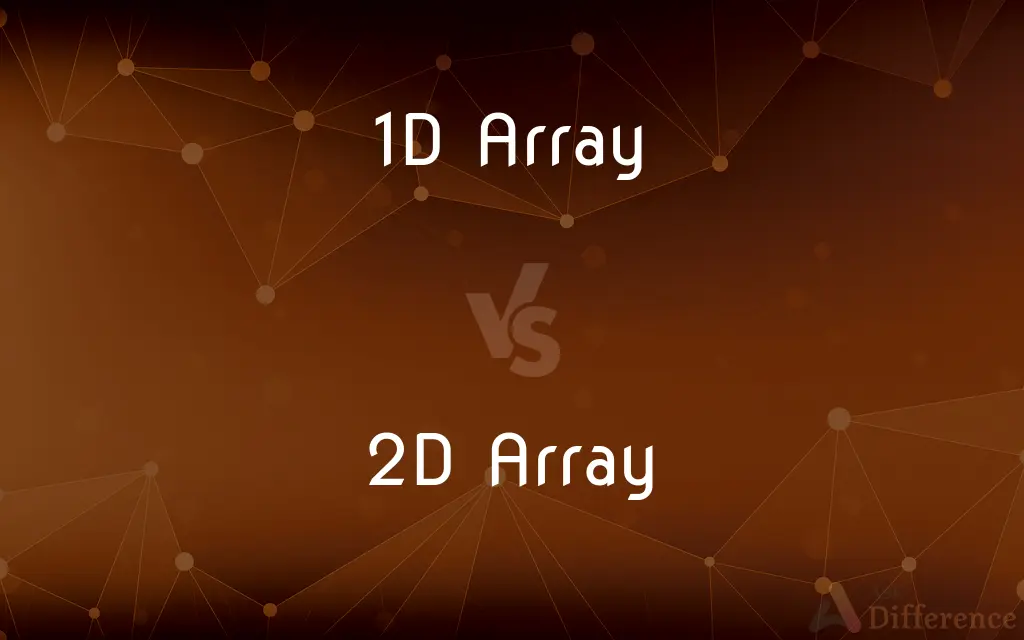1D Array vs. 2D Array — What's the Difference?
By Tayyaba Rehman & Urooj Arif — Published on January 31, 2024
A 1D array is a single row or column of elements, while a 2D array is a matrix-like structure with rows and columns.

Difference Between 1D Array and 2D Array
Table of Contents
ADVERTISEMENT
Key Differences
A 1D Array, often called a one-dimensional array, is a sequence of elements in a linear format, typically represented as a single row or column. A 2D Array, or two-dimensional array, is a collection of items arranged in rows and columns, resembling a table or grid.
In a 1D Array, each element is accessed by a single index, denoting its position in the row or column. In contrast, elements in a 2D Array require two indices to locate an item, one for the row and one for the column.
1D Arrays are simpler and used for basic data storage where data can be represented linearly. 2D Arrays are used for more complex data representations, like matrices in mathematics or tables in databases.
Memory allocation for a 1D Array is straightforward, as it's a contiguous block of elements. For a 2D Array, memory can be contiguous in row-major or column-major order, or non-contiguous, depending on the implementation.
Operations on a 1D Array are generally faster and less complex due to its linear nature. Operations on a 2D Array can be more complex and time-consuming, as they may involve rows, columns, or the entire matrix.
ADVERTISEMENT
Comparison Chart
Structure
Linear sequence of elements
Matrix of elements in rows and columns
Indexing
Single index to access elements
Two indices for row and column
Complexity
Simpler, suitable for linear data
More complex, for multi-dimensional data
Memory Allocation
Contiguous linear memory
Can be row-major, column-major, or non-contiguous
Use Cases
Basic data storage and operations
Complex operations like matrix calculations
Compare with Definitions
1D Array
It allows linear access and manipulation of its elements.
Scores[2] = 95; modifies the third element in a 1D array of scores.
2D Array
A 2D Array involves nested arrays within a parent array.
Let imagePixels = [[255, 0], [0, 255]]; is a 2D array for pixel data.
1D Array
A 1D Array is a collection of elements in a linear order.
Let numbers = [1, 2, 3]; represents a 1D array of numbers.
2D Array
A 2D Array has elements accessible by row and column indices.
Grid[1][0] = 5; accesses and modifies a 2D array element.
1D Array
It is a single-row or single-column structure in programming.
Let names = [Alice, Bob, Charlie]; is a 1D array of strings.
2D Array
It can store more complex data like matrices and tables.
Let chessboard = [['R', 'N'], ['P', 'P']]; uses a 2D array for game representation.
1D Array
A 1D Array is used for simple list-like data structures.
Let temperatures = [23, 25, 22]; stores temperature data in a 1D array.
2D Array
A 2D Array is a table-like structure with rows and columns.
Let matrix = [[1, 2], [3, 4]]; represents a 2D array or matrix.
1D Array
A 1D Array has a single layer of elements without nesting.
Let colors = [red, green, blue]; is a flat 1D array of color names.
2D Array
It is used to represent grid or matrix-like data structures.
Let spreadsheet = [[10, 20], [30, 40]]; is a 2D array for tabular data.
Common Curiosities
What is a 2D Array?
A 2D Array is a collection of elements arranged in rows and columns, requiring two indices for access.
What is a 1D Array?
A 1D Array is a linear sequence of elements accessible with a single index.
How do you access elements in a 1D Array?
Elements in a 1D Array are accessed using a single index representing their position.
How do you access elements in a 2D Array?
Elements in a 2D Array are accessed using two indices: one for the row and one for the column.
Can you convert a 1D Array to a 2D Array?
Yes, by grouping elements of the 1D Array into nested arrays, it can be converted into a 2D Array.
How do you initialize a 1D Array?
A 1D Array is initialized by specifying its size and optionally its elements.
How do you initialize a 2D Array?
A 2D Array is initialized by specifying the dimensions and optionally the elements for each row and column.
Are operations on a 1D Array faster than on a 2D Array?
Generally, operations on a 1D Array are faster due to its linear structure and simpler memory allocation.
What are common uses of 1D Arrays?
1D Arrays are commonly used for storing simple lists or sequences of data.
Are 2D Arrays always square?
No, 2D Arrays can be rectangular, with different numbers of rows and columns.
Can 1D Arrays store different types of data?
Yes, but it's generally advisable to store homogeneous data types in a 1D Array for simplicity.
What are common uses of 2D Arrays?
2D Arrays are used for more complex data structures like matrices, tables, and grid layouts.
Can 2D Arrays have uneven rows?
Yes, 2D Arrays can have rows of different lengths, although it's less common.
How is memory allocated for a 2D Array?
Memory for a 2D Array can be allocated contiguously in row-major or column-major order, or non-contiguously.
Can you store a 2D Array inside a 1D Array?
Technically, a 2D Array can be represented in a 1D Array, but accessing elements requires calculations to map 2D indices to a 1D index.
Share Your Discovery

Previous Comparison
ArrayList in Java vs. Vector in Java
Next Comparison
Albinism vs. LeucismAuthor Spotlight
Written by
Tayyaba RehmanTayyaba Rehman is a distinguished writer, currently serving as a primary contributor to askdifference.com. As a researcher in semantics and etymology, Tayyaba's passion for the complexity of languages and their distinctions has found a perfect home on the platform. Tayyaba delves into the intricacies of language, distinguishing between commonly confused words and phrases, thereby providing clarity for readers worldwide.
Co-written by
Urooj ArifUrooj is a skilled content writer at Ask Difference, known for her exceptional ability to simplify complex topics into engaging and informative content. With a passion for research and a flair for clear, concise writing, she consistently delivers articles that resonate with our diverse audience.
















































